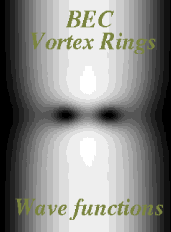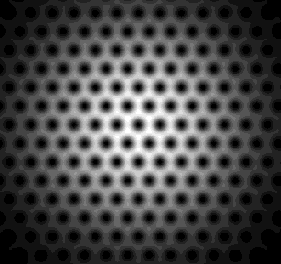The Gross-Pitaevskii model for cold atoms
Trapped atomic Bose-Einstein condensates is a system that is now widely used as a standard model of condensed matter. It is described, in a mean-field approximation, by a nonlinear Schrödinger equation. We typically include a trapping potential in the model which accounts for the trapping of the atomic cloud. The obtained equation is the Gross-Pitaevskii model.
The coherence inherent in condensates is what makes them a great model system for mathematical studies. We are interested in solitary waves in a confined geometry (quantized vortices, vortex rings and solitons) and we study nonlinear dynamics in this physical system.
Superfluid vortex rings

We conjectured the existence of traveling vortex rings in a trapped BEC and calculated them numerically [Phys. Rev. B, 2002]. Observation of static vortex rings was first reported in [Anderson et al, PRL 2001] and many experiments followed.
We found vortex ring modes (that is, energy and momentum of these nonlinear waves as a function of their velocity) and gave their connection to other nonlinear modes in the same system. Specifically, a soliton develops to become a vortex ring as the system turns from one-dimensional to three-dimensional. Hybrids of solitons and vortex rings exist in an intermediate region. We have shown the relation between solitons, vortex rings and also quantised vortices, thus giving the big picture for solitary waves in trapped BECs (within the related Gross-Pitaevskii model).
Solitons in Gross-Pitaevskii models have a non-standard linear momentum, as first noted by [Tsuzuki, 1971]. Vortex rings inherit this feature while they also present an unusual energy-momentum dispersion relation. We drew attention to the fact that static vortex rings have a nonzero linear momentum. As a result, the vortex ring modes present roton-like features. The overall features of vortex rings are unique. This is reflected in the fact that, despite their being quite complex mathematically, they have been occurring in experiments and studied continuously since their first observation in 2001. They occur in a variety of experimental contexts while efforts have been made to make connections to other known modes in quantum field theories.
Our work on vortex rings in trapped superfluids has been the basis for the understanding of vortex rings in currently available atomic BECs, e.g., [Ginsberg et al, PRL 2005]
Quantized vortices in a trapped BEC
One of the most remarkable characteristics of Bose-Einstein condensates is their response to rotation. Rotation in these superfluids occurs via the creation of quantized vortices. A few vortices or a lattice of vortices may be created, while even their fine features can be observed and studied.
Motivated by the experiments reported in [PRL, 2002] we studied theoretically the single vortex excitations in spherical and elongated condensates as a function of the interaction strength. We solved numerically the Gross-Pitaevskii equation and we found two types of vortices, called S- and U-vortices. These have two different precession frequencies and angular momenta. The S vortex is related to the solitonic vortex, which is a nonlinear excitation in the nonrotating system and to the dark soliton. The U-vortex is a generalisation of the standard notion of a vortex filament. [PRA, 2005]. We further derived a class of virial relations for single vortex states in a confined Bose-Einstein condensate. [PRA, 2005].
Vortex lattices
Fast rotation of a BEC results in the formation of a vortex lattice. The system is then in a new phase and it is interesting that it can undergo a type of phase transitions between vortex lattices with different symmetries.

One typically expects to find a standard Abrikosov lattice (triangular vortex lattice). We have verified that but we have noted the surprising fact that the envelope for the condensate density follows a strong interactions profile (Thomas-Fermi profile) even at low condensate densities (i.e., low interactions). [PRA, 2004]
For condensates where long-range dipolar interactions are present vortex lattices can appear in unusual forms. We find lattices of various symmetries: triangular and square vortex lattices, “stripe crystal” and “bubble crystal”. [PRA, 2007]
Non-abelian models.
Non-Abelian potentials can be generated in BECs owing to the impressive control experimentalists hae in ultra-cold atomic systems. Non-Abelian potentials transform BECs to laboratories of exotic many-body phenomena. We studied vortex lattices generated by large effective non-Abelian magnetic fields and showed that the nature of the ground state changes dramatically, with structural changes of the vortex lattice. [PRA, 2012]
Presentation
- "Single vortices and vortex pairs in Bose-Einstein Condensates", Max-Planck Institute for the Physics of Complex Systems, Dresden, 2006.